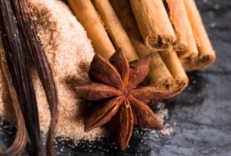I grew up in a household where the head cook, my mom, used abundant amounts of sugar. Being caretaker of the family sweet tooth, she sweetened everything. We’d eat fresh orange slices sprinkled with sugar. Sweet corn needed cooking in boiling water spiked with sugar to guarantee it was not field corn disguised as table fare. Imagine her delight when pre-sweetened Kool Aid appeared on store shelves; she could add a cup or two of her own to give us that extra sugar buzz. We had dessert at all three meals daily – even breakfast – with a cookie, doughnut, or sugar-glazed bear claw.
My family’s other senses of sourness, saltiness, and bitterness were upstaged by sweet. In fact salt was something that was foreign to our table. I should thank mom for saving us all from visits later in life to the cardiologist because of damage done to our tickers by too much salt. However my dentist smiles every time he sees my capped and crowned teeth. And as for that umami taste (Huh?), a “loan word” kidnapped from the Japanese, mom would have scoffed at anything tasting pleasant and savory coming from seaweed. How could that possibly belong in the kitchen?
Mom must be turning over in her grave today with the announcement of our sixth sense: oleogustus. Just the name conjures skepticism. In the 1950’s and 60’s Oleo was the name of a cheap substitute for real butter. This anemic, squishy margarine sold in a sturdy, flexible plastic container came with a bright red blister of food coloring (which probably contained Red Dye #2 or some other killer substance.) One Saturday task at our house was puncturing that blister and squeezing that chemical color into every nook and cranny of the container to make this mimic resemble its dairy cow equivalent.
The interesting name, oleogustis, comes from a group of nutrition researchers: “Oleo” is the Latin root word for oily or fatty (who knew?) and “gustus” is the food experts’ favorite way to describe old-fashioned good taste. What this renders down to is that fat, with all its creamy smoothness, along with its element of bitterness, enhances things like chocolate, coffee, and wine. So raise a glass to all mothers like mine who loved fat and used lard, tallow, and schmaltz to add that extra zip to all things sweet and delicious.


3 thoughts on “How Many Human Tastes Are There Anyway?”
Comments are closed.